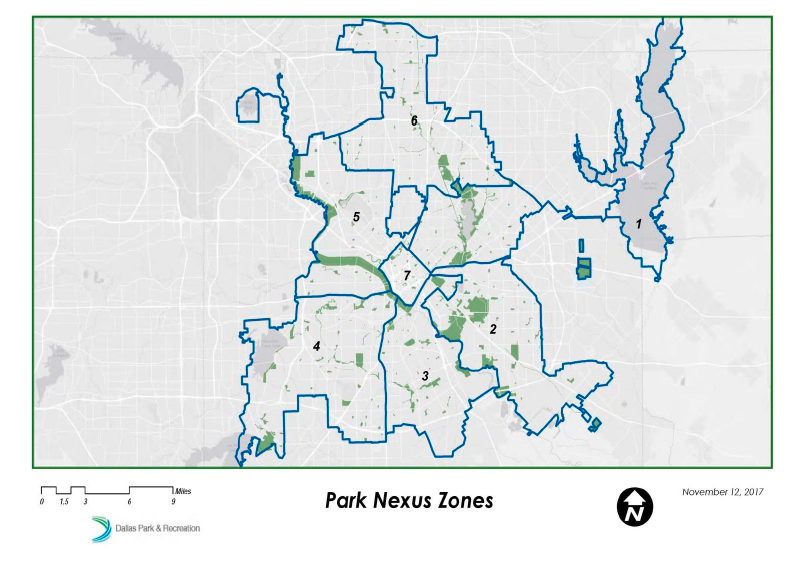Dallas’ growth has long been measured by concrete poured. In boom times, developers snap up land and turn lots of dirt but plant very few trees, to the extent that only 60 percent of the city’s residents are within a 10-minute walk of a public park.
While recent decades have seen investment in the trails and big-ticket projects that look good in tourism bureau promotional materials, the city’s community parks system appears much like it did in the ’70s and ’80s: puny and hard to discern in a sea of glass, cement, and steel. This is why a neighborhood like Uptown’s State Thomas, poster child for North Texas’ new urbanism, is bereft of much dedicated greenspace, and it’s why a summer afternoon in the barely walkable surface lot that is downtown Dallas feels like the city is trying to burn you alive.
Counting on boom times to come, Dallas is trying to ensure that there’s a little more green to break up all that fresh concrete. A proposed park land dedication ordinance would require developers to either set aside land for parks near their new developments or pay city fees (don’t say taxes!) dedicated to building new greenspace or toward funding capital improvement parks projects. The proposal, first floated here as early as 15 years ago but squashed by builders and city officials obsessed by growth at any cost, was revived in the last year and a half, ping-ponging between the parks board, the city planning commission, and various committees until now. The ordinance finally makes its way to the full City Council next month, and the parks board is hoping to see it implemented at the start of next year.
There’s nothing especially radical about the proposal, versions of which are already in place in the state’s other largest cities, as well as most of Dallas’ suburbs. It’s also not a new idea. Corpus Christi has had one since 1955, in an era not known for dense cities and green urbanism.
It has nevertheless been met with some pushback from developers represented by The Real Estate Council, but there are some indications that they might have been appeased at the negotiating table. In an email, Linda McMahon, TREC’s president, says the association is reviewing the ordinance and has not yet taken a formal position. That’s not a no!
Elected officials on the City Council’s quality of life committee raised some additional concerns at a briefing this week. At least one brow was furrowed over cost, which seems to be aligned with ordinances in Dallas’ suburbs. (This presentation goes into more detail. In short, builders must dedicate park acreage according to the number of residential units built, as well as their density, or pay a varying fee. For example, a 150-unit apartment complex of mixed one-bed and two-bed units would require either 0.71 acres of park land, or $82,350. A single-family 20-home development would need either o.2 acres, or $23,000.)
Among other things, there were differing opinions on the legality and administrative practicality of spending development fees collected for parks in one “nexus zone,” a terrible name for the seven parks districts the city is split into, in another “nexus zone” that may have a greater need for greenspace. As in, why can’t we take the green money collected from the construction of Uptown’s latest 200-unit luxury-living high-rise monstrosity, and send it toward a parks project that may help spur badly needed development somewhere in southern Dallas?

Right now, the ordinance has those fees staying in the neighborhood where the development is going up, which could be seen as an unfair advantage for areas already enjoying hot real estate markets. Parts of Uptown and—in another less-built out example cited by proponents of the proposal—the Cedars are as barren of parks as anywhere in Dallas, but people are going to build apartment complexes and hotels and, soon, parks in those neighborhoods, despite the extra costs created by the ordinance. Will they do the same in southern Dallas? Shouldn’t the city’s poorer residents have as much access to a neighborhood park as the twentysomething marketing associate that just signed a $1,500-a-month lease for 300 square feet on McKinney Avenue?
Regardless, no City Council member is going to be anti-parks. They might as well be anti-puppies, or anti-breathable air. The ordinance seems likely to move forward, perhaps with some edits.
Addressing some of the issues raised by council members, Parks Board President Bobby Abtahi says the ordinance could help create opportunities in southern Dallas, where land is cheap enough that the dedicated park acres could add up quickly, to the benefit of residents and enterprising builders. Just because the development is in downtown and Uptown now doesn’t mean it won’t move elsewhere in the long-term.
And issues of equity in a city as economically segregated as Dallas go deeper than anything a parks ordinance can handle. The city’s in-the-works housing and economic development policies will have to complement parks, part of a holistic vision for the future that Dallas has often lacked.
It’s better late than never, Abtahi says. Imagine the last 30 years of growth in North Dallas had this park ordinance been in place. Imagine all the greenspace the city might have. Imagine this ordinance was in place before the bond package and its $262 million for parks were approved last year. Dallas now has to think for the next 30 years, Abtahi says.
As the city becomes more dense, it will need to become a better place to live. It will need to be the kind of vibrant town that attracts young families and workers, and yes, companies like Amazon, along with the opportunity (and dilemmas) they bring.
“We’ve poured enough concrete,” Abtahi says. “It’s time to have some greenspace.”





